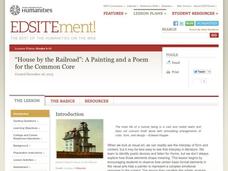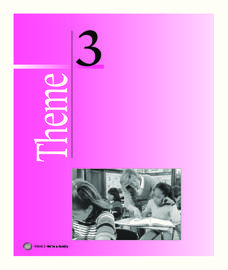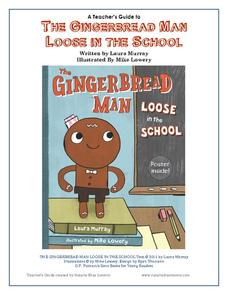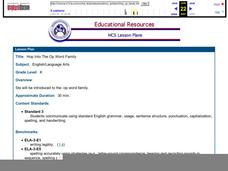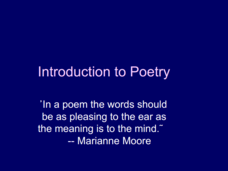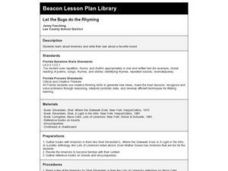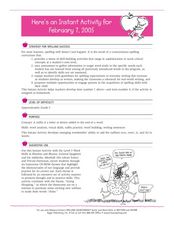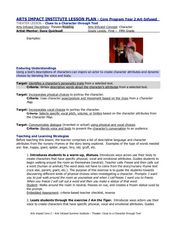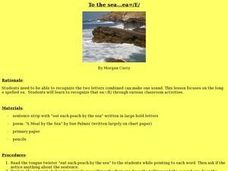National Endowment for the Humanities
“House by the Railroad”: A Painting and a Poem for the Common Core
Introduce your class to ekphrastic poetry with an exercise that asks them to examine Edward Hooper's painting House by the Railroad and Edward Hirsch's poem "Edward Hopper and the House By the Railroad." After a close reading...
Houghton Mifflin Harcourt
We’re a Family: English Language Development Lessons (Theme 3)
Teach your English language learners how to talk about their families with three weeks of lessons. Over the course of the thematic unit, learners pick up new vocabulary so that they can talk about families and relationships, clothing,...
National Park Service
The Poet's Toolbox
If you need a lesson for your poetry unit, use two poems by Henry Wadsworth Longfellow ("Rain in Summer" and "The Slave in the Dismal Swamp") and a resource on Elements of Poetry. The lesson plan guides you through activities...
Curated OER
Vowel Sounds: I and O
Early readers put their short vowel know how to the test. They read a series of simple cvc words, circle all the words that contain the medial short vowel sound indicated, then write those words in the space provided. Phonics, reading,...
Penguin Books
A Teacher's Guide to The Gingerbread Man Loose in the School
What if the Gingerbread Man was trying to catch you, rather than the other way around? Pupils can find out what happens by reading the story The Gingerbread Man Loose in the School by Laura Murray and enrich their experience with the...
Curated OER
Poetry Project
Choosing a poet or a theme, eighth graders conduct research in the world of poetry. They conduct Internet research and select five poems that fit their poet or theme, and create a seven slide PowerPoint presentation on their selected...
Curated OER
Hop Into the Op Word Family
An engaging lesson plan that teaches the /op/ word family is here for you. In it, learners utilize a PowerPoint and a worksheet embedded in the plan to help them better-understnad this word family. This fun lesson plan should be a hit...
Curated OER
Pictures in Words: Poems of Tennyson and Noyes
Students examine how Tennyson and Noyes use words to paint vivid pictures. They read and analyze two poems, complete an online scavenger hunt, complete a worksheet, and write examples of alliteration, personification, metaphor, simile,...
Curated OER
Japanese Poetry: Tanka? You're Welcome!
Learners explore tanka, a form of Japanese poetry. They read and analyze tankas to determine the structure and intent, and compose a traditional and a non-traditional tanka.
Curated OER
Introduction to Poetry
What makes a poem a poem? Give your class a basic understanding of some of the different aspects of poetry by showing them a slide show of poetic devices and elements. The presentation is quite long, so you might split it up into a few...
Curated OER
Figurative and literal language through the study of Shakespeare
Sixth graders explore figurative and literal language. They study literary devices through short pieces of Shakespeare's work. Then investigate Shakespeare's works and life.
Curated OER
Let the Bugs do the Rhyming
Students listen to limericks and write their own about a favorite insect.
Curated OER
Personal Poetry Books
Pupils work in the classroom and in the computer lab to produce a Personal Poetry Book.
Curated OER
Spelling Activity: Suffixes
Understanding spelling patterns is a vital tool. Suffixes ful, ness, ment, and ly are examined in this spelling patterns activity. The class determines how to use each suffix to change the meaning of a set of given root words.
Curated OER
Clues to a Character through Text
Readers will read a text and fill out a character map based on the characters in that text. They will explore different qualities of each character for their map. this can be modified to support younger learners. They will learn about...
BBC
Reception
A nice lesson on recognizing and counting from one to nine is here for you. In it, learners hold up number cards which reflect the number of monkeys who are left during a reading of the story, "How Many Monkey's Left?" A simple lesson...
Curated OER
How We Feel
Students examine how their feelings make them unique. They read and discuss a poem, develop a list of feelings, and create a drawing of them feeling happy and healthy.
Curated OER
Who's in the Shed?
Second graders examine the cover of the book, WHO'S IN THE SHED? and talk about the animals portrayed and the noises they make. They then read the book as a class, looking through the peepholes and making predictions.
Curated OER
A Plump and Perky Turkey
Help readers recognize elements in a story. They will use pictures and text to gain meaning from written material. Have learners listen to the story A Plump and Perky Turkey and participate in a discussion. They recognize the...
Curated OER
To the Sea
Improve pronunciation and phonemic awareness in your first and second graders! With this plan, they distinguish between the sounds for short vowel e and long vowel e. They are introduced to the vowel patterns that comprise long vowel...
Pyro Innovations
Phonemic Awareness
What was the sound that letter made? The letter S is the phoneme of today's lesson and it is ready to make an appearance. Little ones discuss the sound S makes, then they hold up S cards every time they hear words containing the...
Curated OER
To Market
Learners examine the process of cooking a meal. In this cooking background lesson, students explore cooking utensils, recipes, songs, and literature. They go through stations that encourage dramatic play and hands-on exploration of...
Office of Migrant Education
Poetry: Form, Syllables, Mood, and Tone
Looking for a resource to introduce homeschoolers and other out-of-class learners to the elements of poetry? Check out this packet that defines and illustrates important poetry terms.
Curated OER
Focus on Figurative Language
Using the poems "First Snow" by Ted Kooser and "Eating Alone" by Yi-Young Lee (or other suggested poems by Robert Frost or Sara Teasdale), middle schoolers search for examples of figurative language. Guide your learners by discussing...
